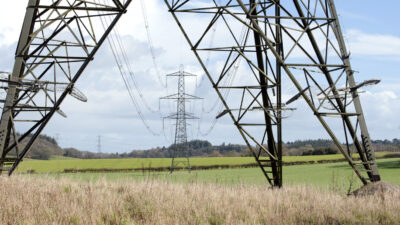Will an online sales tax save the UK high street?
The ‘death of the high street’ has been seriously debated in the UK since 2011 when the Portas Review highlighted the effects of internet shopping, out-of-town shopping centres, congestion, and the lack of local leadership.1 The debate has been renewed by the recent effects of COVID-19 on the high street, with a shift towards more online shopping, which is likely to represent a structural, rather than temporary shift.2 This coincides with the launch of a review of business rates in England—a tax levied on the occupiers of commercial properties.3 The review is expansive—it reconsiders all aspects of this tax, from how it is calculated, which firms pay it, and whether it should be reduced in size or scope. As part of this, the review introduces the idea of Online Sales Tax (OST), the rationale for which appears to stem from concerns about the impact of online shopping sales on the high street. Levying an online sales tax would, it is suggested, help rebalance the tax burden between the two modes of selling.
What are business rates?
Taxes on land and property are levied by many governments. In the UK the most important tax on commercial property is known as business rates. It acts a little like an extra rental payment that has to be made to the state, in addition to the rent payable to the landlord. (It is also payable by owner-occupiers, calculated as if they were renters.) A ‘rateable value’ is calculated for each property, which is then multiplied by a percentage figure relevant to the business occupying the property to arrive at the annual tax payable.
Business rates raise about £25bn in tax revenues England—approximately 3% of total UK tax revenues.4
An online sales tax
What does ‘online’ actually mean? The UK Office for National Statistics characterises e-commerce as electronic data interchange (EDI) sales (business to business sales) or website sales.5 While this definition might seem straightforward, the distinction between online and offline transactions is often not well defined.
For example, website sales often include both a delivery or a ‘click and collect’ option, where the client can pay at the retailer premises or at selected points. Similarly, some restaurants have started to take orders electronically, where the customer places the order and pays online before receiving the food and consuming it on the premises (an increasingly common practice since the onset of COVID-19). Arguably, in both of these examples, what constitutes an online transaction is far from clear and would therefore need to be carefully specified.
The online−offline distinction matters for two reasons: first, the definition of an online sale affects how significant the OST could be in terms of raising revenues, since a narrower definition implies a lower revenue base; second, the definition affects the degree to which it creates distortions and the effects it has more generally.
How much revenue could an online sales tax raise?
As noted above, business rates raise about £25bn in tax revenues England. Thus if an OST is seen as something that acts as a partial replacement or complement to business rates, then one might anticipate that an OST would need to raise several billion pounds in tax revenues.
Reflecting the uncertainty about what online sales actually are, there is a wide range of estimates for the likely revenue base for an OST: our initial analysis suggests values between £54bn and £120bn.6 To raise around £2.5bn of tax revenue—which would represent around 10% of business rate revenues—would require an OST in the region of 2−5%.
Taxes of these magnitudes could cause significant economic distortions. While it is sometimes argued that very small taxes—such as the 0.1% or 0.01% financial transaction taxes—do not create significant distortions, taxes in the range of 2−5% are too large for such a claim to be credible.
The OST would be levied on the sales of merchants selling online. Thus, it is these merchants who would write the cheque to HMRC. However, it is often not the person or entity writing the cheque who really pays the tax. For example, while the VAT return is made by the sellers, in some instances, it is the buyer that pays the VAT, since the price they pay is higher than it would be without VAT. One can see this from studies of various taxes—such as when VAT rates change, when fuel or alcohol duties are varied, or when changes in stamp duty land tax affect house prices.7
This is known as tax incidence. Depending on who bears the tax, the economic distortion faced may differ. Given that the supply of land is largely fixed and the supply of property is relatively inelastic, one could argue that the incidence of business rates is likely to fall upon landlords—that is, in the absence of business rates, any gain will likely be made by land and property owners. The tax incidence of an OST, on the other hand, is likely to be shared between both consumers and businesses. In this way, switching from business rates to an OST will likely benefit land and property owners, and be paid for by consumers and businesses.
Policy trade-offs
All taxes risk creating distortions and economic impacts—for example, by taking a share of the rewards taxes can discourage individuals and firms from undertaking productive activity. As the saying goes, a fine is a tax for doing something wrong, while a tax is a fine for doing something right. However, not all taxes are equal—some taxes, and some types of taxes, are at greater risk of creating significant distortions than others.8
Depending on the public policy objectives, some distortions can be desirable. For example, a tax on cigarettes increases the prices, and deters some users from smoking. The lower overall consumption arising from the tax therefore distorts behaviour, as it is using the tax to change people’s purchasing habits. However, in this way, the tax can both raise revenue and achieve a health policy objective.
Generally, economic evidence indicates that taxes on income (e.g. personal income, business profits) or selective sales taxes (e.g. sales taxes applied to some goods, but not others) have greater potential to create distortions than those that are levied in a more lump sum nature (e.g. business rates, council tax). This is because the former taxes tend to reduce the incentive to undertake work or purchase taxed activities, in favour of non-taxed activities.
In contrast, more lump sum-orientated taxes have less of this effect—for example, the business rates you pay do not depend on the profitability of the business operating there, and so are less prone to distorting incentives to make more sales.9
Some relevant effects to consider for the introduction of an online tax include:
- Online vs high street—there are two broad direct effects. First is a switching effect from online to offline, if there is a high level of substitution between online and offline. Second is a price-raising effect, if there is low cross-price elasticity (i.e. online and offline are poor substitutes), such that the OST results in a rise in prices for online buyers.10
- Environmental impacts of the OST—diverting online sales to offline may well generate additional global emissions (e.g. of CO2), local emissions (e.g. of NOx), and congestion (e.g. due to car journeys). The effect must be traded off against lower usage of private cars—it may be more efficient for a single delivery driver to serve a neighbourhood, rather than a series of individual car trips to the shops.
- Distributional effects among different categories of consumers—there is likely to be differential usage of the internet and online purchasing among different socio-economic groups, and there is a need to examine whether certain categories of vulnerable customer (e.g. those who are elderly or disabled, or who have a low income) may be more substantially impacted by an OST. Indeed, COVID-19 has encouraged more consumers to shop online, with the Government encouraging online grocery shopping for members of high-risk groups.11
Practical implementation
Due to business rates being a property occupation-based tax, it is easy to identify who is liable for the tax and how much is due. For this reason, business rates have a very high collection rate of 98.3%.12 This compares to a collection rate of 93% for VAT, which is lower as it suffers from submission of accurate sales figures, has a complex structure of exemptions, and is therefore easier to evade.13 The administration of the OST is likely to look more like VAT than business rates.
If an OST is only applied to consumer goods, then differentiating between customer types adds an additional burden to businesses. Consider, for example, an online business selling bathroom tiles to tradespeople and directly to DIY consumers. From a VAT perspective, this is handled through the tax return of the tradesperson, precisely for the reason that the seller cannot be expected to check the status of each of their customers. For an OST, whether it is the responsibility of the seller to administer this, or whether some other mechanism needs to be involved, remains to be debated.
Further policy choices remain, including the choice of whether to include international sellers charging the OST on imported goods bought online. Such a tax would presumably supplement existing customs duties and require additional administration. Excluding imported goods from the OST would create distortions and favour international sellers over domestic sellers. There is also a temptation for politicians to introduce further distortions—for instance, by exempting food or grocery shopping (as is the case with VAT). While such carve-outs may set out to help certain groups of individuals, they introduce more economic distortions, and administrative complexity.
A detailed assessment an OST would need to consider the administrative details of the tax, exactly who it applies to, and how it is proposed to be collected.
Will an online sales tax save the UK high street?
The growth in online sales is undoubtedly one of the causes of the UK high street’s decline. An OST may assist some bricks-and-mortar businesses if there is a high level of substitutability between online and offline purchases, and if the tax were set sufficiently high to deter online purchases. Revenues from an OST might also be used to reduce the business rates bill for high street retailers, thereby reducing their costs as well as increasing revenues.
However, there are many reasons why the UK High Street is in decline, and at least one of them—out-of-town shopping—would likely also benefit from an OST. Indeed, as the Portas Review concluded, the ‘days of a high street populated simply by independent butchers, bakers and candlestick makers are, except in the most exceptional circumstances, over’.
1 Portas, M. (2011), ‘The Portas Review An independent review into the future of our high streets’, December.
2 Oxera (2020), ‘Three reasons to be positive’, Today’s Agenda, April.
3 HM Treasury (2020), ‘Business Rates Review: Call for Evidence’, July.
4 The business rate receipts in England amount to approximately £25bn—see Ministry of Housing, Communities and Local Government (2020), ‘National non-domestic rates collected by councils in England: forecast for 2020 to 2021: Official Statistics’. According to the Office for National Statistics (ONS), public sector current receipts amount to approximately £825bn—see ONS (2020), ‘Public Sector Finances’, 21 August.
5 ONS (2019), ‘E-commerce and ICT activity, UK: 2018’, November, chapter 3.
6 Before the onset of COVID-19, around 20% of sales were online in the UK (rising to around 30% during the COVID-19 disruption), with around £400bn of retail sales in total, implying that online sales are worth around £80bn−£120bn. ONS (2020), ‘Internet sales as a percentage of total retail sales (ratio) (%)’, 24 July. In contrast, a narrower definition that focuses just on website sales of retail products yields an estimate of £54 billion. (This excludes, for example, food, transport services, and wholesale products.) ONS (2019), ‘E-commerce and ICT activity, UK: 2018’, November, Table 3.
7 There are many studies in this field. See, for example, Barrell, R., and Weale, M. (2009), ‘The Economics of a Reduction in VAT’, Fiscal Studies, 30:1, pp. 17−30; and Pike, R., Lewis, M., and Turner, D. (2009), ‘Impact of VAT reduction on consumer price indices’, Economics & Labour Market Review, 3, pp. 17−21.
8 In this context, an distortion is one which distorts economic behaviour, and distorts the choices that individuals, firms and investors make. Where two taxes are raise the same amount of revenue, i.e. fiscal neutrality, the imposition of a tax can distort the economic choices. These choices can affect labour input, capital/labour trade-offs, investment/savings, and productivity.
9 The effects of taxation on economic efficiency are discussed in detail in the Mirrlees review—see in particular Mirrlees Review (2011), Tax by Design, ch. 2, ‘The Economics Approach to Tax Design’.
10 For example, various empirical studies are available in the empirical economic literature: see, for example, Dinner, I. M., van Heerde, H. J., and Neslin, S. A. (2013), ‘Driving Online and Offline Sales: The Cross-Channel Effects of Traditional, Online Display, and Paid Search Advertising’, Journal of Marketing Research, 51:5, pp. 527−45; Zhang, X. (2018), ‘Three Essays on Consumer Demand in Online and Offline Markets’, Theses and Dissertations, 4333.
11 See, for example, the government guidance for purchasing online.
12 Ministry of Housing, Communities and Local Government (2020), ‘National non-domestic rates collected by councils in England: forecast for 2020 to 2021: Official Statistics’.
13 HM Revenue and Customs (2020), ‘Measuring tax gaps 2020 edition: Tax gap estimates for 2018 to 2019’.
Download
Related

Future of rail: how to shape a resilient and responsive Great British Railways
Great Britain’s railway is at a critical juncture, facing unprecedented pressures arising from changing travel patterns, ageing infrastructure, and ongoing financial strain. These challenges, exacerbated by the impacts of the pandemic and the imperative to achieve net zero, underscore the need for comprehensive and forward-looking reform. The UK government has proposed… Read More

Investing in distribution: ED3 and beyond
In the first quarter of this year the National Infrastructure Commission (NIC)1 published its vision for the UK’s electricity distribution network. Below, we review this in the context of Ofgem’s consultation on RIIO-ED32 and its published responses. One of the policy priorities is to ensure… Read More

